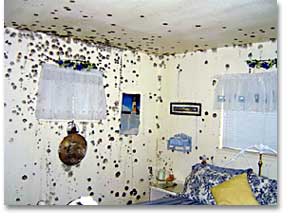|
|
 The Mossman cometh |
|
Are we winning the War on Mold?
Reports from the front lines in HumCo's never-ending struggle
story and photo by CAMERON LANGFORD
As Eric Stockwell, general manager of the New Life Service contracting company, led his guest through company headquarters in Eureka, he smiled, turned his glance to the air and evaluated an invisible presence.
"Do you smell the mold?" he asked. "It's everywhere."
He was only kidding, but if anyone could sniff
out trace  elements of the
Humboldt County's curse in New Life's sterile offices, Stockwell
would be the guy. The engaging, 30-something, blue-eyed manager,
whose boyish charm is underscored by his braces, is more attuned
to mold than most folks not currently suffering from it. Though
he graduated from UC Davis with a degree in anthropology, Stockwell
has since devoted his talents to becoming one of the county's
top mold-busters -- a full-time warrior in the soggy North Coast's
eternal battle against the natural forces that wish to eat our
homes, one by one.
elements of the
Humboldt County's curse in New Life's sterile offices, Stockwell
would be the guy. The engaging, 30-something, blue-eyed manager,
whose boyish charm is underscored by his braces, is more attuned
to mold than most folks not currently suffering from it. Though
he graduated from UC Davis with a degree in anthropology, Stockwell
has since devoted his talents to becoming one of the county's
top mold-busters -- a full-time warrior in the soggy North Coast's
eternal battle against the natural forces that wish to eat our
homes, one by one.
Right: Excessive mold growth on drywall.
Mold spores are undetectable to the naked eye. They're simple organisms, and they're everywhere, and in a rainbow of varieties -- brown, brownish-purple, gray, dark green, black and even white. They're in the air you're breathing as you walk outside, swirling secretly about your person. In this outdoor, airborne form, they're virtually harmless. Along with their fungi kin, mushrooms and yeasts, molds play a crucial role in breaking down organic material and recycling nutrients in the environment. These substances provide sustenance for molds. Once the spores secure a food source they only need one thing already in utter abundance on the North Coast to reproduce with the vigor of oversexed gremlins -- moisture.
Unfortunately, these spores are present indoors, and, as anyone who has lived on the Humboldt County coast for any amount of time can attest, that's where things become problematic. While no one minds the mold going about its business in the forest, it's a different matter inside your own home. For its indoor dining, mold enjoys a buffet of man-made materials -- sheetrock, tile, books. As long as there's a little water for it to land on, mold will make a pig of itself, wholeheartedly attempting to devour your humid bathroom, kitchen sink, leaky plumbing, wet carpet, damp drapes.
In his bookcase-laden office, far from any of the dirty work one imagines serious mold removal would entail, Stockwell plots strategy against the enemy. When he gets the call from a homeowner who finds himself on the losing end of a skirmish, he'll spring to action, making an on-site visit to assess the state of play. Later, he sends out his soldiers -- trained mold specialists wearing jeans and black polo shirts bearing the company's logo.
In his 11 years at the company, which specializes in fixing structural damage brought by the elements, Stockwell has seen it all. With regards to mold, he's found that sometimes people's fears of the threat, which often include worries about its effect on their health, overtake the reality.
"There's a certain amount of hype and hysteria there," Stockwell said. "Women in an office building will call and say, 'It smells musty and I've had this cold longer than I should have,' and I don't see it. And they'll say, 'Well, it's in the air.'"
Most times, though, the mold is real, and sometimes the carnage is grim. One call that particularly impressed Stockwell involved a multi-floor, unoccupied vacation home in Shelter Cove. A broken hot-water pipe somewhere at the top of the four-bedroom, two-bath dwelling had fed a colony of mold spores that was now living it up, free to spread its splotchy, black plague until what grew resembled a perverted paint-by-numbers illustration gone severely awry. The house required an extreme makeover. New Life stripped the entire home of its walls and flooring, threw away the dry wall and insulation. In cases this severe, the company usually calls in specialists to measure the air for mold spores afterwards. Many times, Stockwell said, he calls on Terry Clark, an environmental consultant for Eureka's Winzler and Kelly.
"You're looking for specific mold types you'd find due to moldy building materials," said Clark, whose authoritative pipes resemble a nightly newscaster's "voice of God." "We'll compare results from outdoor and indoor samples. Hopefully, if it's remediated, we should find no samples, or the same amount, or less than outside."
We've all heard of and cringed at the fabled black mold, but both Stockwell and Clark indicated this term is simply a generalization for many of the 2,000 varieties of mold. However, one particular mold with a name straight out of a nightmare -- Stachybotrys chartarum -- is a known pathogen, Clark said.
Most often, mold contamination poses no threat to health. But Clark said some molds in high concentration, when combined with a susceptible person or repeated exposure, can be carcinogenic and deadly. He has first-hand evidence of mold's ability to ravage those unaware of its presence. "My father-in-law was a corn farmer in Iowa," he said. "And he inhaled corn mold from wet corn in a silo, and it destroyed his lungs."
But mold, while everywhere, is hard to pin down. If mold, under the right conditions can become deadly, when can we know when the levels are unsafe? This question was on the minds of the California legislature in 2001, when it passed the Toxic Mold Protection Act (Senate Bill 372). The statute mandated the state Department of Health Services to conduct tests, with the goal of setting guidelines for how much mold exposure is too much.
"I do lead testing, and in those situations you have thresholds or permissible exposure limits and if you're below that level [your home] is clean," Clark said. But when it comes to mold, he said, scientists haven't been able to determine a threshold. "It would take them a great deal of time and money to do it, and they don't have the budget," he said. Besides California's absence of a standard, there are no federal mold guidelines either.
This elusive quality of mold is why the county division of environmental health only investigates mold they can see, or that emanates from obvious structural deficiencies. The department receives an estimated 300 mold-related calls a year, and though winter is the wettest season locally, it doesn't necessarily elicit the most responses. The increased temperature of summer can also cause mold problems.
Many times, said Kevin Metcalfe, a county environmental health specialist, the mold issues stem from the occupants' neglect or "operational" issues. Under such circumstances a perfectly well-built home will fall victim to mold because people don't ventilate or attend to problem areas -- water-logged window sills, leaky roofs, etc. Often times, Metcalfe added, the presence of mold has to do with the type of housing. Older homes with less ventilation, and particularly Victorians, are more of a challenge due to poor insulation causing temperature differences (uneven heating).
One thing Metcalfe does in his own home to increase air circulation is to move all his furniture four to six inches from the wall to prevent moisture from being trapped between the surfaces and result in mold growth.
For Kim Horn, a McKinleyville resident, that advice could have saved her antique desks from turning blue from the heartless fungus. Two years ago, Horn opened her closet and found the walls had turned blue. Even her leather jackets had taken on the hue of hungover Smurfs. Why? Aside from the cracked concrete slab which allows moisture to enter through the floor of her apartment, Horn said the location of the closet led to the outbreak. Since the closet is against an outside wall that's constantly collecting water, eventually that moisture found its way inside and blossomed in a shade of Blue Raspberry Blow Pop.
Horn didn't contact the county about the mold in her apartment because she feared retaliations from her landlords. "A lot of times they'll say, 'If you can't handle it, we'll get someone in there who can,'" she said. Instead, she covered her windows with plastic, bought a $5 salt substance from Rite-Aid that pulls moisture from the air into a small receptacle that "really works."
Not contacting the county to complain about the problem was a smart move on Horn's part -- they likely wouldn't have done anything more than to give her some literature, advice and a good-luck pat. The county's health department, Metcalfe said, acts as a housing authority only in the unincorporated areas of the county. They do, however, investigate housing code violations county-wide. The agency generally acts as a referee between the city, landlord, and complaining tenant to ensure a mold-ridden home or apartment meets housing standards. Moving someone out due to health concerns with the rampant fungus would be extremely rare, if not extraordinary, Metcalfe said.
Though experts may not be exactly sure just how damaging this uninvited guest can be, just how much havoc it can wreak on our immune system, the consensus is that while mold is dwelling in homes throughout Humboldt County and the world over, and pops up with the ease of clover in the grass, eradicating the fungus is in your best interests.
"If someone thinks they're experiencing adverse health effects they should really be evaluated," Metcalfe said. "If you can see or smell a mold problem then it should be taken care of."
COVER STORY | IN THE NEWS | STAGE MATTERS | OFF THE PAVEMENT | ARTBEAT
TALK OF THE
TABLE | THE HUM | CALENDAR
Comments? Write a letter!
© Copyright 2006, North Coast Journal, Inc.

